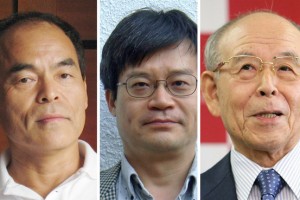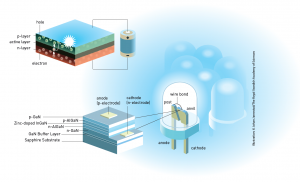
Agence France-Presse/Getty Images
A trio of scientists were awarded the Nobel Prize in Physics for inventing the blue light-emitting diode (LED), leading to the creation of modern LED light bulbs.
Japanese citizens Isamu Akasaki, a professor at both Meijo University and Nagoya University, Hiroshi Amano of Nagoya University and US citizen Shuji Nakamura – who is also a professor at the University of California in Santa Barbara – were jointly awarded the prize of 8 million Swedish kroner ($1.26 million) in recognition of their work in creating the inexpensive and non-toxic lighting.
The invention of the humble but powerful blue LED marks a paradigm shift in lighting technology. As the 20th century was lit by incandescent bulbs, the 21st century will increasingly be dominated by tiny LED lamps, which have found their way into computer and mobile phone screens, possibly even the screen you are reading this on.

Royal Swedish Academy of Sciences
Speaking to the Wall Street Journal, Staffan Normark of the Royal Swedish Academy of Sciences said LEDs have a huge potential to transform the way our streets are lit in future.
“You just have to go out on the street and see that these LED lamps are taking over, replacing Edison bulbs completely, making much longer-lasting, much stronger light to illuminate the world,” Normark said.
Red and green LEDs have been around for almost 50 years, but the ultimate goal was to combine them with a blue LED to create white light, a problem that had eluded labs and companies the world over.
Creating a crystal of gallium nitride – the key ingredient in manufacturing a blue LED – proved highly complex and elusive, but Dr Akasaki and Dr Amano were the first to create a high-quality gallium nitride crystal in 1986.
Six years later, they successfully created a diode that emitted blue light.
With almost a quarter of electricity production used for lighting, the arrival of LED bulbs is transforming the way offices and homes are lit, providing a longer-lasting and highly power-efficient option to the filament bulbs invented by Thomas Edison at the turn of the 19th century.
LED lamps can last as much as 100 times longer than traditional lights, making them cheaper to purchase in the long run. They also contain no mercury, which reduces the impact discarded lamps have on the environment.
As they consume very low power, LED lights can also be connected with cheap solar power, a benefit for the more than 1.5 billion people over the world who do not have access to reliable lighting.
